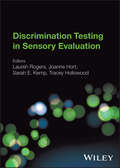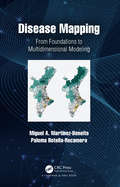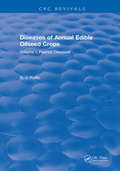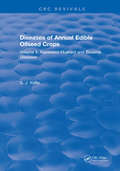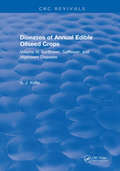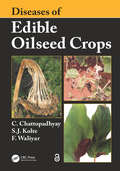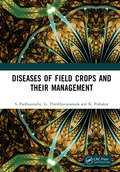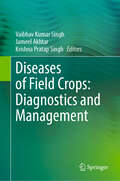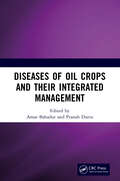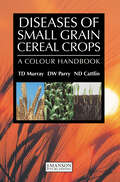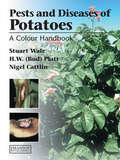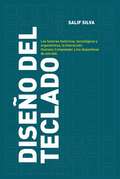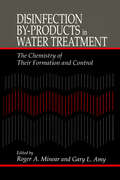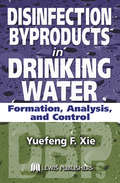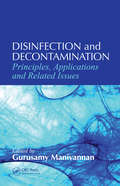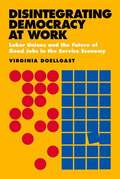- Table View
- List View
Discriminating Taste: How Class Anxiety Created the American Food Revolution
by S. Margot FinnFor the past four decades, increasing numbers of Americans have started paying greater attention to the food they eat, buying organic vegetables, drinking fine wines, and seeking out exotic cuisines. Yet they are often equally passionate about the items they refuse to eat: processed foods, generic brands, high-carb meals. While they may care deeply about issues like nutrition and sustainable agriculture, these discriminating diners also seek to differentiate themselves from the unrefined eater, the common person who lives on junk food.Discriminating Taste argues that the rise of gourmet, ethnic, diet, and organic foods must be understood in tandem with the ever-widening income inequality gap. Offering an illuminating historical perspective on our current food trends, S. Margot Finn draws numerous parallels with the Gilded Age of the late nineteenth century, an era infamous for its class divisions, when gourmet dinners, international cuisines, slimming diets, and pure foods first became fads. Examining a diverse set of cultural touchstones ranging from Ratatouille to The Biggest Loser, Finn identifies the key ways that “good food” has become conflated with high status. She also considers how these taste hierarchies serve as a distraction, leading middle-class professionals to focus on small acts of glamorous and virtuous consumption while ignoring their class’s larger economic stagnation. A provocative look at the ideology of contemporary food culture, Discriminating Taste teaches us to question the maxim that you are what you eat.
Discrimination Testing in Sensory Evaluation (Sensory Evaluation)
by Tracey Hollowood Joanne Hort Sarah E. Kemp Lauren RogersDiscrimination Testing in Sensory Evaluation Provides a complete and unified approach to discrimination testing in sensory evaluation Sensory evaluation has evolved from simple "taste testing" to a distinct scientific discipline. Today, the application of sensory evaluation has grown beyond the food industry—it is a sophisticated decision-making tool used by marketing, research and development, and assurance in industries such as personal care, household care, cosmetics, fragrances, automobile manufacturing, and many others. Sensory evaluation is now a critical component in determining and understanding consumer acceptance and behavior. Discrimination Testing in Sensory Evaluation provides insights into the application of sensory evaluation throughout the entire product life cycle, from development to marketing. Filled with practical information and step-by-step guidance, this unique reference is designed to help users apply paired comparison tests, duo-trio tests, triangle tests, similarity tests, and various other discrimination tests in a broad range of product applications. Comprehensive chapters written by leading experts provide up-to-date coverage of traditional and cutting-edge techniques and applications in the field. Addresses the theoretical, methodological, and practical aspects of discrimination testing Covers a broad range of products and all of the senses Describes basic and more complex discrimination techniques Discusses the real-world application of discrimination testing in sensory evaluation Explains different models in discrimination testing, such as signal detection theory and Thurstonian modelling Features detailed case studies for various tests such as A- not AR, 2-AFC, and Ranking among others to enable practitioners to perform each technique Discrimination Testing in Sensory Evaluation is an indispensable reference and guide for sensory scientists, in academia and industry, as well as professionals working in R&D, quality assurance and control, and marketing. It is also an excellent textbook for university courses and industry vocational programs in Sensory Science.
Discrimination of Mobile Supramolecular Chirality: Acylative Molecular Transformations by Organocatalysis (Springer Theses)
by Ayumi ImayoshiThis book proposes a novel concept for molecular recognition. In the field of asymmetric synthesis approaching the mature science, asymmetric discrimination and catalytic synthesis of chiral supramolecules still stand as unsolved problems. The extreme difficulty in asymmetric synthesis of such supramolecules may result from the mobile nature of supramolecular chirality. Here the author shows the first highly enantioselective synthesis of mechanically chiral supramolecules. In the presence of a chiral organocatalyst, a mechanically planar chiral rotaxane was obtained with p erfect enantiopurity (>99% ee) with an excellent selectivity. The dynamic and flexible recognition mode enabled asymmetric synthesis of supramolecules with conformational flexibility and mobility. The recognition mode of the catalyst is a contrast to the traditional static and rigid recognition mode of the typical conventional catalysts. The concept of dynamic molecular recognition will be adopted as a novel concept in a wide range of fields beyond the field of organic chemistry, including material chemistry, biochemistry, and medicinal chemistry.
Disease Causing Microbes
by Jaishree PaulThis book provides knowledge on the diversity of disease-causing microbes including bacteria, viruses, fungi and protozoans—the major diseases they cause and the environmental factors that influence the occurrence, transmission and spread of microbes along with the epidemiological factors determining the occurrence of disease. The book mainly covers a broad spectrum of diseases infecting different organs of human and describes the microorganisms involved in the process. The diseases caused by parasites and helminths are also included in the text since the infective stages of parasites as well as helminths are microscopic in nature and need to be distinguished from bacterial infections by appropriate diagnosis.
Disease Mapping: From Foundations to Multidimensional Modeling
by Miguel A. Martinez-Beneito Paloma Botella-RocamoraDisease Mapping: From Foundations to Multidimensional Modeling guides the reader from the basics of disease mapping to the most advanced topics in this field. A multidimensional framework is offered that makes possible the joint modeling of several risks patterns corresponding to combinations of several factors, including age group, time period, disease, etc. Although theory will be covered, the applied component will be equally as important with lots of practical examples offered. Features: Discusses the very latest developments on multivariate and multidimensional mapping. Gives a single state-of-the-art framework that unifies most of the previously proposed disease mapping approaches. Balances epidemiological and statistical points-of-view. Requires no previous knowledge of disease mapping. Includes practical sessions at the end of each chapter with WinBUGs/INLA and real world datasets. Supplies R code for the examples in the book so that they can be reproduced by the reader. About the Authors: Miguel A. Martinez Beneito has spent his whole career working as a statistician for public health services, first at the epidemiology unit of the Valencia (Spain) regional health administration and later as a researcher at the public health division of FISABIO, a regional bio-sanitary research center. He has been also the Bayesian Hierarchical Models professor for several seasons at the University of Valencia Biostatics Master. Paloma Botella Rocamora has spent most of her professional career in academia although she now works as a statistician for the epidemiology unit of the Valencia regional health administration. Most of her research has been devoted to developing and applying disease mapping models to real data, although her work as a statistician in an epidemiology unit makes her develop and apply statistical methods to health data, in general.
Disease Resistance in Crop Plants: Molecular, Genetic and Genomic Perspectives
by Shabir Hussain WaniHuman population is escalating at an enormous pace and is estimated to reach 9.7 billion by 2050. As a result, there will be an increase in demand for agricultural production by 60–110% between the years 2005 and 2050 at the global level; the number will be even more drastic in the developing world. Pathogens, animals, and weeds are altogether responsible for between 20 to 40 % of global agricultural productivity decrease. As such, managing disease development in plants continues to be a major strategy to ensure adequate food supply for the world. Accordingly, both the public and private sectors are moving to harness the tools and paradigms that promise resistance against pests and diseases. While the next generation of disease resistance research is progressing, maximum disease resistance traits are expected to be polygenic in nature and controlled by selective genes positioned at putative quantitative trait loci (QTLs). It has also been realized that sources of resistance are generally found in wild relatives or cultivars of lesser agronomic significance. However, introgression of disease resistance traits into commercial crop varieties typically involves many generations of backcrossing to transmit a promising genotype. Molecular marker-assisted breeding (MAB) has been found to facilitate the pre-selection of traits even prior to their expression. To date, researchers have utilized disease resistance genes (R-genes) in different crops including cereals, pulses, and oilseeds and other economically important plants, to improve productivity. Interestingly, comparison of different R genes that empower plants to resist an array of pathogens has led to the realization that the proteins encoded by these genes have numerous features in common. The above observation therefore suggests that plants may have co-evolved signal transduction pathways to adopt resistance against a wide range of divergent pathogens. A better understanding of the molecular mechanisms necessary for pathogen identification and a thorough dissection of the cellular responses to biotic stresses will certainly open new vistas for sustainable crop disease management. This book summarizes the recent advances in molecular and genetic techniques that have been successfully applied to impart disease resistance for plants and crops. It integrates the contributions from plant scientists targeting disease resistance mechanisms using molecular, genetic, and genomic approaches. This collection therefore serves as a reference source for scientists, academicians and post graduate students interested in or are actively engaged in dissecting disease resistance in plants using advanced genetic tools.
Diseases at the Wildlife - Livestock Interface: Research and Perspectives in a Changing World (Wildlife Research Monographs #3)
by Joaquín Vicente Kurt C. Vercauteren Christian GortázarShared diseases among wildlife, livestock and humans, often transboundary, are relevant to public health and global economy, as being highlighted currently relative to the global COVID19 pandemic. Diseases at these interfaces also impact the conservation of biodiversity and must be considered when managing wildlife. While wildlife and domestic livestock have coexisted in dynamic systems for thousands of years, spillover disease risks are higher today than in the past due to global patterns of increasing close contact and interactions among wildlife, livestock and humans in the context of complex, diverse and numerous circumstances. Multidisciplinary studies of animal interfaces, especially those involving wildlife, therefore, must be brought to the forefront so that knowledge gaps can be realized and filled to inform managers and policy makers.In the first part of the book authors illustrate and discuss ecological and epidemiological concepts related to the interfaces, with a vision towards socio-ecological system health. In addition, the history of past animal interfaces provides the necessary perspective to focus current questions, better understand present situations, and informs how we can best approach the future. The second part discusses the myriad of similar and differing wildlife- livestock interfaces found around the world from a regional point of view. The third part focuses on how to assess the spatial and temporal overlap between livestock and wildlife, and authors present new technical innovations about how inter-transmissions between wild and domestic populations can be quantified. An overview of main modeling approaches available to quantify multi-host disease transmission at the wildlife/livestock interface, illustrated with specific-case studies, is also presented. Finally, the need for interdisciplinary approaches and a dedicated thematic field to approach the wildlife/livestock interfaces and create opportunities to promote wildlife–livestock coexistence is emphasized. The concluding chapter presents perspectives and directions to better understanding disease dynamics at the wildlife/livestock interface, global change and implications for the future. The changing distribution of interfaces, ongoing human and environmental changes (e. g. climate warming, changes in animal production systems, etc.) and their likely impacts and consequences for the interfaces and disease transmission processes are all discussed.
Diseases in Legume Crops: Next Generation Breeding Approaches for Resistant Legume Crops
by Harsh Nayyar Kadambot H. M. Siddique Prashant Singh Uday Chand Jha Kamal Dev Sharma Eric J Bishop von WettbergThe edited book covers all major and minor diseases in grain legumes (chickpea, pigeon pea, lentil, mung bean, common bean, groundnut, and soybean) and forages legumes (including Medicago, rice bean, and faba bean) and their control measures by using various breeding approaches.Grain legumes are versatile nutritionally rich crops, and are one of the important components of global food security. However, grain legumes are severely challenged by various major and emerging minor diseases causing serious limitations in grain yield and production. Thus, to minimize the negative impact of the growing yield loss caused by these diseases, several approaches have been developed and embraced. This book covers all the latest development in genetics, breeding, genomics, and molecular biology tools for combating various major and minor emerging diseases in all the grain legumes from expert authors. Chapters in this title contain all the relevant illustrations and statistical data detailing the present scenario and identifying the gap for meeting the future demand for sustaining global protein security by developing disease-resistant cultivars. This book is of interest to graduate and postgraduate students, researchers, and policymakers to understand the impacts of various diseases on yield loss in legume crops.
Diseases of Annual Edible Oilseed Crops: Volume I: Peanut Diseases
by S. J. KolteThese three volumes deal with the diseases of primarily cultivated annual edible oilseeds, i.e., peanut (groundnut), rapeseed-mustard, sesame, sunflower, safflower, and nigerseed. It is reliably believed that this book will be of great help not only to students, reseachers, and teachers but also to agricultural extension workers, field workers, seed growers, and seed crop inspectors, and subsequently to the farmers, to achieve the over-all objective of increase in oilseed crop yields throughout the world.
Diseases of Annual Edible Oilseed Crops: Volume II: Rapeseed-Mustard and Sesame Diseases
by S. J. KolteThese three volumes deal with the diseases of primarily cultivated annual edible oilseeds, i.e., peanut (groundnut), rapeseed-mustard, sesame, sunflower, safflower, and nigerseed. It is reliably believed that this book will be of great help not only to students, reseachers, and teachers but also to agricultural extension workers, field workers, seed growers, and seed crop inspectors, and subsequently to the farmers, to achieve the over-all objective of increase in oilseed crop yields throughout the world.
Diseases of Annual Edible Oilseed Crops: Volume III: Sunflower, Safflower, and Nigerseed Diseases
by S. J. KolteThese three volumes deal with the diseases of primarily cultivated annual edible oilseeds, i.e., peanut (groundnut), rapeseed-mustard, sesame, sunflower, safflower, and nigerseed. It is reliably believed that this book will be of great help not only to students, reseachers, and teachers but also to agricultural extension workers, field workers, seed growers, and seed crop inspectors, and subsequently to the farmers, to achieve the over-all objective of increase in oilseed crop yields throughout the world.
Diseases of Commercial Crops and Their Integrated Management
by Amar Bahadur Pranab DuttaThis volume compiles information on different aspects of diseases of commercial crops and their management. It contains 17 chapters based on different crops contributed by various authors. The book will be helpful for the students pursuing their degree in Agricultural Sciences, growers, teachers, extension personnel, and fellow researchers in their respective fields.
Diseases of Edible Oilseed Crops: Volume Ii: Rapeseed-mustard And Sesame Diseases
by Chirantan ChattopadhyayDiseases of Edible Oilseed Crops presents an unprecedentedly thorough collection of information on the diseases of cultivated annual oilseed crops, including peanut, rapeseed-mustard, sesame, soybean, sunflower, and safflower. Written by internationally recognized researchers, this book covers and integrates worldwide literature in the field up to
Diseases of Field Crops and their Management
by S. Parthasarathy G. Thiribhuvanamala K. PrabakarThe book entitled Diseases of Field Crops and their Management provides most recent information about major diseases of cultivation field crops, their symptoms, pathogen characters, epidemiology, and management. In order to make the book all in one, the importance of major diseases has also been dealt with in brief. Note: T&F does not sell or distribute the Hardback in India, Pakistan, Nepal, Bhutan, Bangladesh and Sri Lanka.
Diseases of Field Crops: Diagnostics and Management
by Krishna Pratap Singh Vaibhav Kumar Singh Jameel AkhtarThis edited book is a compilation of the chapters on the recent advances made in the field of disease management in various field crops. It covers host resistance, regulatory mechanism as well as non-chemical methods and computer-based applications in disease management. Molecular marker assisted selection, proteomic approaches, CRISPR-Cas mediated technology to improve food quality and minimize negative public health impact associated with crop diseases is also discussed. Plant diseases continue to be major challenge to global crop production, especially field crops, inflicting not only crop yield losses to farmers, but also decline quality as well as nutritional value leading threat to global food security. According to FAO statistics, there is a need of 70% steady increase in agricultural production to fulfil the food requirements of 9.1 billion populations by 2050, and annual global crop losses due to pests and diseases have been estimated to be about 30%. Therefore, the book aims at bringing out a comprehensive information on field crop diseases, plant disease detection and diagnosis, monitoring, forecasting/forewarning, and management. The book is very useful for students, teachers, researchers, planners/administrators, and also the end users at national and international level.
Diseases of Oil Crops and Their Integrated Management
by Amar Bahadur Pranab DuttaThis volume compiles information on different aspects of diseases of oil crops and their management. It contains 11 chapters based on different crops contributed by various authors. The book will be helpful for the students pursuing their degree in Agricultural Sciences, growers, teachers, extension personnel, and fellow researchers in their respective fields.
Diseases of Small Grain Cereal Crops: A Colour Handbook
by Nigel D. Cattlin T.D. Murray David W. ParryThe small grain cereals wheat, barley, oats and rye are cultivated worldwide. They form the foundation of most agricultural systems and are essential in the manufacture of staple products such as bread, pasta and fermented beverages. Reflecting the global and economic importance of cereal crops, this book aims to make identification of diseases aff
Diseases, Pests and Disorders of Potatoes: A Colour Handbook
by Stuart Wale Bud Platt Nigel D. CattlinCovering the most important pathogens, this handbook provides clear, concise descriptions of the symptoms and cycles of diseases and disorders, and the pests that commonly prey on potato crops, their distribution and importance, and advice on their control. The text is illustrated with some 235 superb color photographs of affected crops to aid in the rapid and accurate identification of disease. It provides a practical reference for professionals and students involved with potato production, handling and storage worldwide.Diseases and Pests covered include: Potato early blight, Gray mould, Black dot, Ring rot, Blackleg, Soft rot, Pit rot, Dry rot and wilt, Violet root rot, Silver scurf, Aster yellows, Witches broom, Pocket rot, Gangrene, Pink rot, Potato late blight, Skin spot, Spraing, Mild Mosaic, Sev. Mosaic, Net Necrosis, Watery wound rot, Leak, Brown rot, Stem canker, Black Scurf, White mould, Powdery scab, Common scab, Wart, Spraing, Verticillium wilt.
Diseño del Teclado: Los factores históricos, tecnológicos y ergonómicos, la Interacción Humano-Computador y los dispositivos de entrada.
by Salif SilvaLo que proponemos en las páginas de este libro es una serie de ideas que pretenden aclarar el debate actual sobre el teclado, por medio de observaciones documentadas, sedimentando las bases para investigaciones futuras. El objeto de estudio de esta publicación es, por lo tanto, el teclado de ordenador en su aspecto esencial, desde la invención de la máquina de escribir, en 1868, hasta la actualidad. Por lo tanto, pretendemos reflexionar sobre su naturaleza, valorando los aspectos históricos, tecnológicos, estéticos y ergonómicos, a través de un levantamiento de los datos en los más diversos dominios ligados al teclado. Por lo tanto, esperamos permitir el reconocimiento de la realidad de los dispositivos de entrada de datos, y la perspectiva del desarrollo de conceptos innovadores y aplicaciones adaptadas a la realidad actual y futura.
Dishwasher's Big Job (The Big Jobs Books)
by Steven Weinberg*FEATURED ON THE TODAY SHOW AS A "GREAT GIFT FOR THE HOLIDAYS"**Don't miss out on the other Big Jobs books - Washer and Dryer's Big Job and Fridge and Oven's Big Job!*Filled with fun facts, giggles galore, and googly eyes, the Big Jobs board books are the perfect introduction for babies and toddlers to the big world around them, starting at home!With vibrant artwork and clever humor, this original board book series is a celebration of childhood curiosity and the most captivating topic of all--household appliances! In Dishwasher's Big Job, follow along as this amazing appliance shows us how your dirty dishes get clean.Dishwasher has a big job to do taking your sloppy spoon, bedraggled bowl, and spilled sippy cup from soiled to sparkling—but so do you! Learn how it’s all done in this rollicking read-aloud that will delight parents and kids alike.
Disinfection By-Products in Water (The Handbook of Environmental Chemistry #135)
by Chao Chen Yuefeng Xie Susan AndrewsThis book offers a comprehensive review of disinfection by-products (DBPs), exploring various aspects from detection methods and precursors to their potential health risks, regulation, and future implications. This book is also a memorial to the 50th anniversary of the first major DBP report in 1974 by Dr. Rook, who identified chloroform in chlorinated drinking water, initiating the study of DBPs. For half a century, chemists, toxicologists, engineers and regulators have been identifying more DBPs, understanding their formation mechanism, evaluating their health effects on the public, and minimizing and controlling their formation in drinking water. Divided into four parts, the book commences with an introduction to the general knowledge of DBPs, shedding light on the significance of DBPs and their impact on water quality. It also delves into the detection methods employed to identify and quantify DBPs, offering readers invaluable insights into cutting-edge techniques and emerging technologies, and explores the sources and characteristics of DBP precursors. In Part II, several expert contributors provide an overview of individual DBPs, including halogenated aliphatic, iodinated, aromatic, and heterocyclic DBPs, discussing their properties and potential implications. The discussion extends to nitrogenous DBPs, the group of nitrosamines, and inorganic DBPs as well. Part III provides an authoritative perspective on the relationship between energy consumption, climate change, and DBP formation, offering also insights into DBPs in the context of water treatment plants, water reuse plants, swimming pools, and everyday life. The book closes with a section devoted to the health effects of DBPs, where particular attention is given to the analysis of the toxicity and health risks associated with DBPs. In this section, readers will find more about the potential adverse effects of DBPs on human health and current research on risk assessment and management strategies. In today's era of water scarcity and increasing demands for safe drinking water, the presence of DBPs has emerged as a critical concern in the field of public health. This book is, therefore, an invaluable resource for researchers, water treatment professionals, public health officials, and policymakers seeking a comprehensive understanding of DBPs.
Disinfection By-Products in Water TreatmentThe Chemistry of Their Formation and Control
by Roger A. Minear Gary AmyDisinfection By-Products in Water Treatment describes new government regulations related to disinfection by-products. It explains the formation of microorganism by-products during water treatment and the methods employed to control them.The book includes several chapters on chlorine by-products and discusses techniques for the removal of chloroform from drinking water. It also describes gamma radiation techniques for removing microorganic by-product precursors from natural waters and the removal of bromate from drinking water.
Disinfection Byproducts in Drinking Water: Formation, Analysis, and Control
by Yuefeng XieThe EPA has established regulations which classify four types of disinfection byproducts - TTHMs, haloacetic acids, bromate, and chlorite - and requires public water systems limit these byproducts to specific levels. Most of the information required to comply with these standards is either scattered throughout the literature or derived from confere
Disinfection and Decontamination: Principles, Applications and Related Issues
by Gurusamy ManivannanIn the battle between humans and microbes, knowledge may be not only the best weapon but also the best defense. Pulling contributions from 34 experts into a unified presentation, Disinfection and Decontamination: Principles, Applications, and Related Issues provides coverage that is both sophisticated and practical. The book reviews the fund
Disintegrating Democracy At Work
by Virginia DoellgastThe shift from manufacturing- to service-based economies has often been accompanied by the expansion of low-wage and insecure employment. Many consider the effects of this shift inevitable. In Disintegrating Democracy at Work, Virginia Doellgast contends that high pay and good working conditions are possible even for marginal service jobs. This outcome, however, depends on strong unions and encompassing collective bargaining institutions, which are necessary to give workers a voice in the decisions that affect the design of their jobs and the distribution of productivity gains. Doellgast's conclusions are based on a comparative study of the changes that occurred in the organization of call center jobs in the United States and Germany following the liberalization of telecommunications markets. Based on survey data and interviews with workers, managers, and union representatives, she found that German managers more often took the "high road" than those in the United States, investing in skills and giving employees more control over their work. Doellgast traces the difference to stronger institutional supports for workplace democracy in Germany. However, these democratic structures were increasingly precarious, as managers in both countries used outsourcing strategies to move jobs to workplaces with lower pay and weaker or no union representation. Doellgast's comparative findings show the importance of policy choices in closing off these escape routes, promoting broad access to good jobs in expanding service industries.

